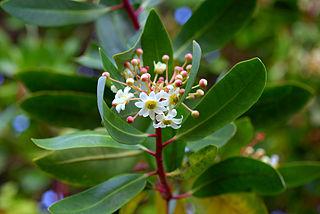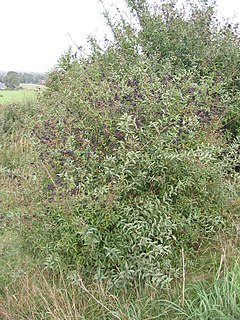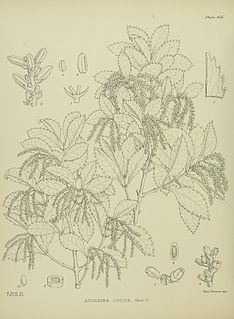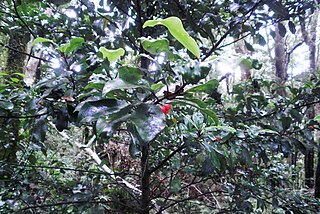
Podocarpus totara is a species of podocarp tree endemic to New Zealand. It grows throughout the North Island and northeastern South Island in lowland, montane and lower subalpine forest at elevations of up to 600 m.

Magnolia grandiflora, commonly known as the southern magnolia or bull bay, is a tree of the family Magnoliaceae native to the southeastern United States, from Virginia to central Florida, and west to East Texas. Reaching 27.5 m (90 ft) in height, it is a large, striking evergreen tree, with large dark green leaves up to 20 cm long and 12 cm wide, and large, white, fragrant flowers up to 30 cm (12 in) in diameter.

Winteraceae is a primitive family of tropical trees and shrubs including 93 species in five genera. It is of particular interest because it is such a primitive angiosperm family, distantly related to Magnoliaceae, though it has a much more southern distribution. Plants in this family grow mostly in the southern hemisphere, and have been found in tropical to temperate climate regions of Malesia, Oceania, eastern Australia, New Zealand, Madagascar and the Neotropics, with most of the genera concentrated in Australasia and Malesia. The five genera, Takhtajania, Tasmannia, Drimys, Pseudowintera, and Zygogynum s.l. all have distinct geographic extant populations. Takhtajania includes a single species, T. perrieri, endemic only to Madagascar, Tasmannia has the largest distribution of genera in Winteraceae with species across the Philippines, Borneo, New Guinea, Eastern Australia, and Tasmannia, Drimys is found in the Neotropical realm, from southern Mexico to the subarctic forests of southern South America, Pseudowintera is found only in New Zealand, and Zygogynum has species in New Guinea and New Caledonia.

Aristotelia serrata, commonly known as wineberry or in the Māori language makomako or just mako, is a small tree in the family Elaeocarpaceae, in the genus Aristotelia, found in the North Island, South Island and Stewart Island of New Zealand.

Coprosma robusta, commonly known as karamu, is a flowering plant in the family Rubiaceae, which is endemic to New Zealand. It can survive in many climates, but is most commonly found in coastal areas, lowland forests, or shrublands. Karamu can grow to be around 6 meters tall, and grow leaves up to 12 centimeters long. Karamu is used for a variety of purposes in human culture. The fruit that karamu produces can be eaten, and the shoots of karamu are sometimes used for medical purposes.

Dracophyllum is a genus of plants belonging to the family Ericaceae, formerly Epacridaceae. There are 61 species in the genus, mostly shrubs, but also cushion plants and trees, found in New Zealand, Australia, Lord Howe Island and New Caledonia. The name Dracophyllum, meaning dragon-leaf, refers to their strong outward similarity to the unrelated Dracaena, sometimes known as dragon tree. Although dicotyledonous, they resemble primitive monocots with their slender leaves concentrated in clumps at the ends of the branches; they are sometimes called grass-trees.

Buxus sempervirens, the common box, European box, or boxwood, is a species of flowering plant in the genus Buxus, native to western and southern Europe, northwest Africa, and southwest Asia, from southern England south to northern Morocco, and east through the northern Mediterranean region to Turkey. Buxus colchica of western Caucasus and B. hyrcana of northern Iran and eastern Caucasus are commonly treated as synonyms of B. sempervirens.

Pseudowintera colorata, also known as mountain horopito or pepper tree, is a species of woody evergreen flowering trees and shrubs, part of family Winteraceae. The species is endemic to New Zealand. All Winteraceae are magnoliids, associated with the humid Antarctic flora of the southern hemisphere.

Ligustrum vulgare is a species of Ligustrum native to central and southern Europe, north Africa and southwestern Asia, from Ireland and southwestern Sweden south to Morocco, and east to Poland and northwestern Iran.

Polygodial is chemical compound found in dorrigo pepper, mountain pepper, horopito, canelo, paracress, water-pepper, and Dendrodoris limbata.

Archeria traversii is a species of shrub in the family Ericaceae.

Ascarina lucida, commonly known as hutu is a species of small tree in the family Chloranthaceae. It is endemic to New Zealand, being common on the West Coast and Nelson regions of the South Island and more rarely found in the North Island. A typical plant association is within the Westland podocarp/broadleaf forests with common understory associates of Blechnum discolor, Pseudowintera colorata, Pseudopanax colensoi and Coprosma lucida. Most genus members are dioecious, producing unisexual male or female flowers on separate plants. Ascarina lucida, the only member of its genus to occur in New Zealand, is monoecious. It will grow to a height of 6m and can have a 30 cm trunk. The leaves which are in opposite pairs are simple, yellowish green in color, have a raised mid rib and are very similar to Laurelia novae-zelandiae. Their margins have prominent teeth which are dark colored at the tips. Ascarina lucida is now nearly extinct in the Taranaki region but was last reported in Oct 1969 at Mt Taranaki, near Pukeiti by Colin Ogle.

The Pseudowintera axillaris is a shrub like tree, endemic to New Zealand. They are members of the Winterace family and are known for their peppery taste, and glossy green leaves.

Polygala myrtifolia, the myrtle-leaf milkwort, is an evergreen 2-4m tall South African shrub or small tree found along the southern and south-eastern coasts, from near Clanwilliam in the Western Cape to KwaZulu-Natal. It is a fast-growing pioneer plant, a typical fynbos component, and may be found on dunes, rocky places, along forest margins, beside streams, and in open grassland. It belongs to the milkwort family of Polygalaceae.
Pimelea traversii is a species of shrub in the family Thymelaeaceae. It is native to New Zealand. The specific epithet traversii is in honor of naturalist Henry H. Travers (1844-1928), son of William Thomas Locke Travers.

Pseudowintera traversii, sometimes called Travers horopito, is a species of woody shrub in the family Winteraceae. The specific epithet traversii is in honor of naturalist Henry H. Travers (1844-1928), son of William Thomas Locke Travers.
P. traversii may refer to a two different species of shrub. The specific epithet traversii refers to someone with the surname 'Travers,' in these cases it's New Zealand naturalist Henry H. Travers (1844–1928).

Dracophyllum traversii, commonly known as mountain neinei, grass tree, and pineapple tree is a species of flowering plant in the heath family Ericaceae. It is a deciduous tree endemic to New Zealand. It reaches a height of 0.2–13 m (0.66–42.65 ft) and has leaves which form tufts at the end of its branches. It has a lifespan between 500 and 600 years.

Dracophyllum elegantissimum, commonly known as grass tree or slender dragon tree, is a flowering plant in the family Ericaceae. Endemic to New Zealand, it is found in the north of the South Island, in north-west Nelson.

















